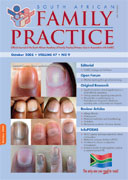Dyschromonychia: clinical significance in a South African population.
Abstract
Background: The purpose of this study was to determine disease associations with dyschromonychia (DCO) in an outand inpatient population attending Kalafong Hospital. Methods: This prospective and observational study included in- and out-patients attending the Immunology Clinic at Kalafong Hospital, Pretoria, Gauteng. The study was divided into three phases, the first of which was to evaluate the kappa values and prevalence of DCO. The second was to determine the disease associations of in-patients, and the third phase consisted of nail evaluation in an out-patient HIV-positive population. Results: The kappa value was 0.72, as obtained by three investigators. DCO was found to have a 66% sensitivity, 92% specificity, 66% positive predictive value, 92% negative predictive value, a positive likelihood ratio of 8.2 and a negative likelihood ratio of 0.4 for HIV (inpatients). Patients with DCO were found to have a significantly higher rate of infections (predominantly involving the lung), significantly lower lymphocyte counts and CD4 cell counts, and significantly lower CD4:CD8 ratios and albumin levels (p = 0.0001). The best discriminatory CD4 for DCO was 216.6 x 10 6/l (sensitivity = 89%; specificity = 63%), while a CD4 value of 134.3 x 10 6/l yielded a sensitivity of 75% and a specificity of 73%. Conclusions: This study demonstrates a close association between HIV and DCO, especially in the case of lower CD4 cell counts. The absence of DCO is a poor predictor for the presence of HIV, although its presence has a high sensitivity for HIV seropositivity. The clinical finding of DCO is a simple, quick and efficient sign for the evaluation of the immune status of our population with reasonable sensitivity and specificity for low CD4 cell counts. (SA Fam Pract 2005;47(8): 54-59)
Published
2005-10-01
Section
Original Research
By submitting manuscripts to SAFP, authors of original articles are assigning copyright to the South African Academy of Family Physicians. Copyright of review articles are assigned to the Publisher, Medpharm Publications (Pty) Ltd, unless otherwise specified. Authors may use their own work after publication without written permission, provided they acknowledge the original source. Individuals and academic institutions may freely copy and distribute articles published in SAFP for educational and research purposes without obtaining permission.

